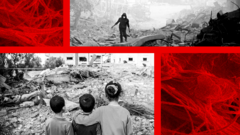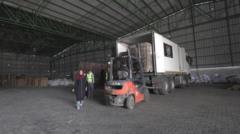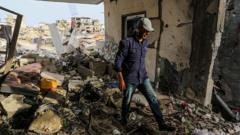Amid ongoing conflict, experts warn that the extensive presence of asbestos can pose severe health risks to residents, potentially leading to life-threatening illnesses in the future.
Toxic Legacy: Asbestos Hazards in Gaza's War-Torn Rubble

Toxic Legacy: Asbestos Hazards in Gaza's War-Torn Rubble
The destruction in Gaza has unveiled a hidden danger: asbestos, a silent killer lurking in the rubble of destroyed buildings.
The recent military operations in Gaza have not only led to significant destruction but have also released a deadly risk: asbestos. Once commonly used in construction materials, asbestos fibers become airborne when disturbed and pose serious health hazards, including cancer. While its use has been banned in many parts of the world, including the UK and Israel, it still remains in older structures, particularly in Gaza’s urban refugee camps established during the 1948-49 Arab-Israeli conflict. The United Nations Environment Programme (UNEP) estimates that approximately 2.3 million tons of rubble in Gaza may be contaminated with this toxic material.
According to Professor Bill Cookson from the National Centre for Mesothelioma Research in London, the current environment in Gaza is extremely hazardous. "The Gaza rubble is a very, very toxic environment," he stated, warning that immediate and long-term health issues are inevitable for the population, particularly affecting children who could carry the consequences for their whole lives. As the conflict continues, awareness of the dangers of asbestos and the means to mitigate these risks are overshadowed by the immediate threat of violence.
The dangers of asbestos exposure include asbestosis and mesothelioma, both serious illnesses that often manifest decades later. Dr. Ryan Hoy has emphasized that due to the densely populated nature of Gaza, avoiding inhalation of asbestos fibers is nearly impossible. Medical professionals on the ground express concerns that as people strive to survive the ongoing conflict, health risks associated with dust and debris are not prioritized.
Historical data indicates that past conflicts have left traces of asbestos in the rubble across Gaza. There are multiple types of asbestos, varying in risk, and the area has previously dealt with highly carcinogenic forms. Globally, 68 countries have prohibited asbestos, yet its legacy lingers, affecting countless lives. As reconstruction efforts commence, experts warn of potential exposure during debris removal, which could take decades and cost billions to manage safely.
As the situation unfolds, the grim prospect of asbestos-related diseases adds to a growing death toll caused by the ongoing military conflict, emphasizing the urgent need for careful handling of contaminated rubble in future rebuilding efforts and heightened awareness of long-term health implications for the people of Gaza.
According to Professor Bill Cookson from the National Centre for Mesothelioma Research in London, the current environment in Gaza is extremely hazardous. "The Gaza rubble is a very, very toxic environment," he stated, warning that immediate and long-term health issues are inevitable for the population, particularly affecting children who could carry the consequences for their whole lives. As the conflict continues, awareness of the dangers of asbestos and the means to mitigate these risks are overshadowed by the immediate threat of violence.
The dangers of asbestos exposure include asbestosis and mesothelioma, both serious illnesses that often manifest decades later. Dr. Ryan Hoy has emphasized that due to the densely populated nature of Gaza, avoiding inhalation of asbestos fibers is nearly impossible. Medical professionals on the ground express concerns that as people strive to survive the ongoing conflict, health risks associated with dust and debris are not prioritized.
Historical data indicates that past conflicts have left traces of asbestos in the rubble across Gaza. There are multiple types of asbestos, varying in risk, and the area has previously dealt with highly carcinogenic forms. Globally, 68 countries have prohibited asbestos, yet its legacy lingers, affecting countless lives. As reconstruction efforts commence, experts warn of potential exposure during debris removal, which could take decades and cost billions to manage safely.
As the situation unfolds, the grim prospect of asbestos-related diseases adds to a growing death toll caused by the ongoing military conflict, emphasizing the urgent need for careful handling of contaminated rubble in future rebuilding efforts and heightened awareness of long-term health implications for the people of Gaza.


















